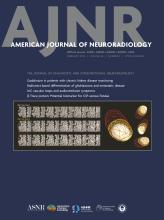This article requires a subscription to view the full text. If you have a subscription you may use the login form below to view the article. Access to this article can also be purchased.
Abstract
BACKGROUND: While the diagnosis of frontotemporal dementia (FTD) is based mostly on clinical features, [18F]-FDG-PET has been investigated as a potential imaging standard in ambiguous cases, with arterial spin-labeling (ASL) MRI gaining recent interest.
PURPOSE: The purpose of this study is to conduct a systematic review and meta-analysis on the diagnostic performance of ASL MRI in patients with FTD and compare it with that of [18F]-FDG-PET.
DATA SOURCES: A systematic search of PubMed, Scopus, and Embase was conducted until March 13, 2024.
STUDY SELECTION: Inclusion criteria were original articles, patients with FTD and/or its variants, use of ASL MR perfusion imaging with or without [18F]-FDG-PET, and presence of sufficient diagnostic performance data. Exclusion criteria were meeting abstracts, comments, summaries, protocols, letters and guidelines, longitudinal studies, and overlapping cohorts.
DATA ANALYSIS: The quality of eligible studies was assessed by using the Quality Assessment of Diagnostic Accuracy Studies-2. Pooled sensitivity, specificity, and diagnostic odds ratio (DOR) for [18F]-FDG-PET and ASL MRI were calculated, and a summary receiver operating characteristic curve was plotted.
DATA SYNTHESIS: Seven eligible studies were identified, which included a total of 102 patients with FTD. Aside from some of the studies showing, at worst, an unclear risk of bias in patient selection, index test, flow, and timing, all studies showed low risk of bias and applicability concerns in all categories. Data from 4 studies were included in our meta-analysis for ASL MRI and 3 studies for [18F]-FDG-PET. Pooled sensitivity, specificity, and DOR were 0.70 (95% CI: 0.59–0.79), 0.81 (95% CI: 0.71–0.88), and 8.00 (95% CI: 3.74–17.13) for ASL MRI and 0.88 (95% CI: 0.71–0.96), 0.89 (95% CI: 0.43–0.99), and 47.18 (95% CI: 10.77–206.75) for [18F]-FDG-PET.
LIMITATIONS: The number of studies was relatively small, with a small sample size. The studies used different scanning protocols as well as a mix of diagnostic metrics, all of which might have introduced heterogeneity in the data.
CONCLUSIONS: While ASL MRI performed worse than [18F]-FDG-PET in the diagnosis of FTD, it exhibited a decent diagnostic performance to justify its further investigation as a quicker and more convenient alternative.
ABBREVIATIONS:
- 3DPCASL
- 3D pseudocontinuous ASL
- AD
- Alzheimer disease
- ASL
- arterial spin-labeling
- bvFTD
- behavioral variant of frontotemporal dementia
- DOR
- diagnostic odds ratio
- FN
- false-negative
- FP
- false-positive
- FTD
- frontotemporal dementia
- NLR
- negative likelihood ratio
- PASL
- pulsed ASL
- PLD
- postlabel delay
- PLR
- positive likelihood ratio
- PRISMA
- Preferred Reporting Items for Systematic Reviews and Meta-Analysis
- QUADAS-2
- Quality Assessment of Diagnostic Accuracy Studies-2
- SROC
- summary receiver operative characteristic
- TN
- true-negative
- TP
- true-positive
- © 2025 by American Journal of Neuroradiology












